Role of Information Technology in Gaining Competitive Advantage
VerifiedAdded on 2023/01/12
|13
|4195
|50
AI Summary
This report discusses the role of information technology in gaining competitive advantage in the business environment. It explores how IT helps in providing satisfaction to consumers, communication, sales, logistics, research & development, and more. The report focuses on The Coco-Cola Company as a case study and analyzes its background information, products and services, competitive environment using Porter's five force analysis, inbound logistics, operations, outbound logistics, and two support activities in Porter's value chain.
Contribute Materials
Your contribution can guide someone’s learning journey. Share your
documents today.
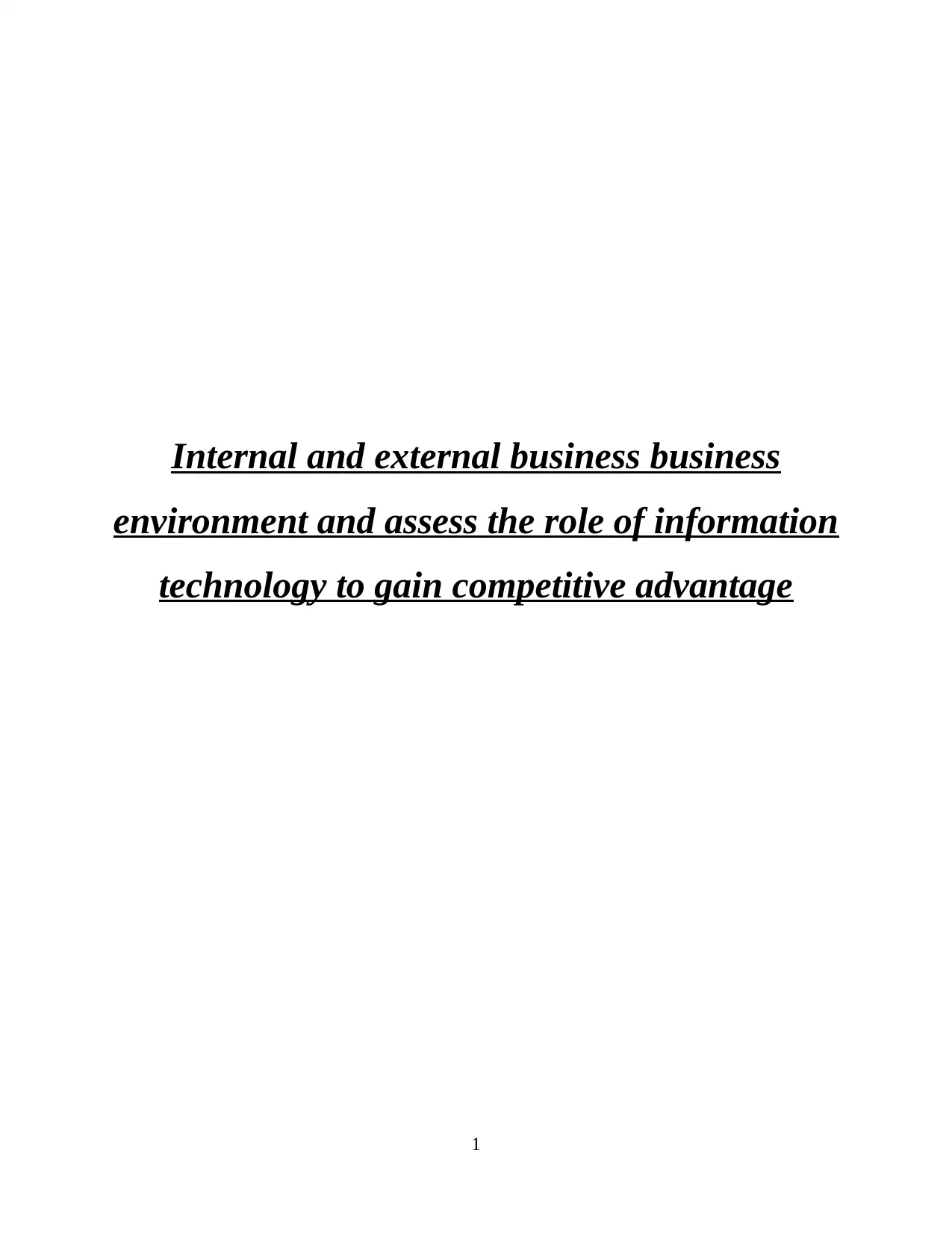
Internal and external business business
environment and assess the role of information
technology to gain competitive advantage
1
environment and assess the role of information
technology to gain competitive advantage
1
Secure Best Marks with AI Grader
Need help grading? Try our AI Grader for instant feedback on your assignments.
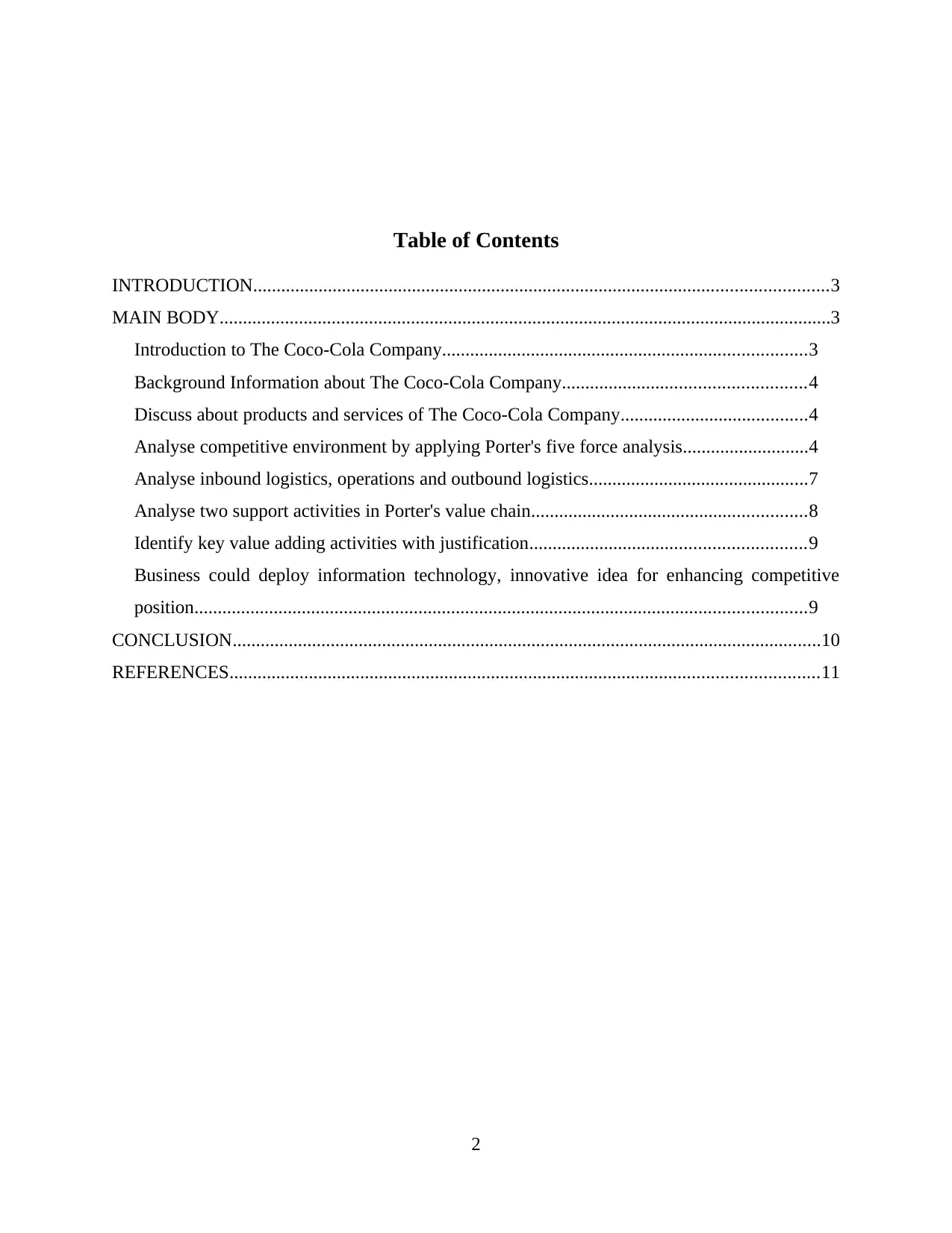
Table of Contents
INTRODUCTION...........................................................................................................................3
MAIN BODY...................................................................................................................................3
Introduction to The Coco-Cola Company..............................................................................3
Background Information about The Coco-Cola Company....................................................4
Discuss about products and services of The Coco-Cola Company........................................4
Analyse competitive environment by applying Porter's five force analysis...........................4
Analyse inbound logistics, operations and outbound logistics...............................................7
Analyse two support activities in Porter's value chain...........................................................8
Identify key value adding activities with justification...........................................................9
Business could deploy information technology, innovative idea for enhancing competitive
position...................................................................................................................................9
CONCLUSION..............................................................................................................................10
REFERENCES..............................................................................................................................11
2
INTRODUCTION...........................................................................................................................3
MAIN BODY...................................................................................................................................3
Introduction to The Coco-Cola Company..............................................................................3
Background Information about The Coco-Cola Company....................................................4
Discuss about products and services of The Coco-Cola Company........................................4
Analyse competitive environment by applying Porter's five force analysis...........................4
Analyse inbound logistics, operations and outbound logistics...............................................7
Analyse two support activities in Porter's value chain...........................................................8
Identify key value adding activities with justification...........................................................9
Business could deploy information technology, innovative idea for enhancing competitive
position...................................................................................................................................9
CONCLUSION..............................................................................................................................10
REFERENCES..............................................................................................................................11
2

INTRODUCTION
Information technology is defined as use of computers in order to retrieve, manipulate,
transmit and store data and information (Alreemy and et. al., 2016). This is used by business for
carrying out their operations and activities in an effective and efficient manner. The use of IT has
made work easy for business and organisation for accomplishment of goal and objectives. IT
play effective part in providing satisfaction to consumer, communication, sales, logistics,
research & development and others. Present report is based on The Coco-Cola Company which
was established on 29th January, 1892 at United States. It is regarded as American multinational
business which manufacture non-alcoholic beverages as well as syrups. The main aim of report
is to discuss about background information along with their products and services. It has also
highlighted about competitive environment with use of Porter's five force model along with
operations, inbound and outbound logistics. The support activities are discussed by using Porter's
value chain.
MAIN BODY
Introduction to The Coco-Cola Company
The Coco-Cola Company is public organisation founded in January 29, 1892 headquarter
at Atlanta, Georgia, United States (.Ciabuschi, Dellestrand and Martín, 2015). It is beverage
industry that manufacture various types of non-alcoholic drinks and syrups for consumers. This
was founded by Asa Griggs Candler and John Smith Pemberton who established Coca-Cola. The
respective organisation is serving worldwide. Key people of The Coco-Cola Company are James
Quincey and Brian Smith who works as Chairman & CEO and President & COO of organisation
respectively. Currently, more than 62,600 employee are working in organisation for attainment
of goal and objectives. The different types of products of respective organisation are Coco-Cola,
crystal, crush, citra and so on. It is largest business in US which has above 2800 products selling
in 200 countries. Different types of assets which are owned by The Coco-Cola Company such as
international beverages private limited, Coca-Cola enterprises, refreshment products Finland Oy
and many more. It is also listed on NYSE as well as part of DJIA, S&P 500 index, Russell 1000
Index and Growth Stock.
3
Information technology is defined as use of computers in order to retrieve, manipulate,
transmit and store data and information (Alreemy and et. al., 2016). This is used by business for
carrying out their operations and activities in an effective and efficient manner. The use of IT has
made work easy for business and organisation for accomplishment of goal and objectives. IT
play effective part in providing satisfaction to consumer, communication, sales, logistics,
research & development and others. Present report is based on The Coco-Cola Company which
was established on 29th January, 1892 at United States. It is regarded as American multinational
business which manufacture non-alcoholic beverages as well as syrups. The main aim of report
is to discuss about background information along with their products and services. It has also
highlighted about competitive environment with use of Porter's five force model along with
operations, inbound and outbound logistics. The support activities are discussed by using Porter's
value chain.
MAIN BODY
Introduction to The Coco-Cola Company
The Coco-Cola Company is public organisation founded in January 29, 1892 headquarter
at Atlanta, Georgia, United States (.Ciabuschi, Dellestrand and Martín, 2015). It is beverage
industry that manufacture various types of non-alcoholic drinks and syrups for consumers. This
was founded by Asa Griggs Candler and John Smith Pemberton who established Coca-Cola. The
respective organisation is serving worldwide. Key people of The Coco-Cola Company are James
Quincey and Brian Smith who works as Chairman & CEO and President & COO of organisation
respectively. Currently, more than 62,600 employee are working in organisation for attainment
of goal and objectives. The different types of products of respective organisation are Coco-Cola,
crystal, crush, citra and so on. It is largest business in US which has above 2800 products selling
in 200 countries. Different types of assets which are owned by The Coco-Cola Company such as
international beverages private limited, Coca-Cola enterprises, refreshment products Finland Oy
and many more. It is also listed on NYSE as well as part of DJIA, S&P 500 index, Russell 1000
Index and Growth Stock.
3
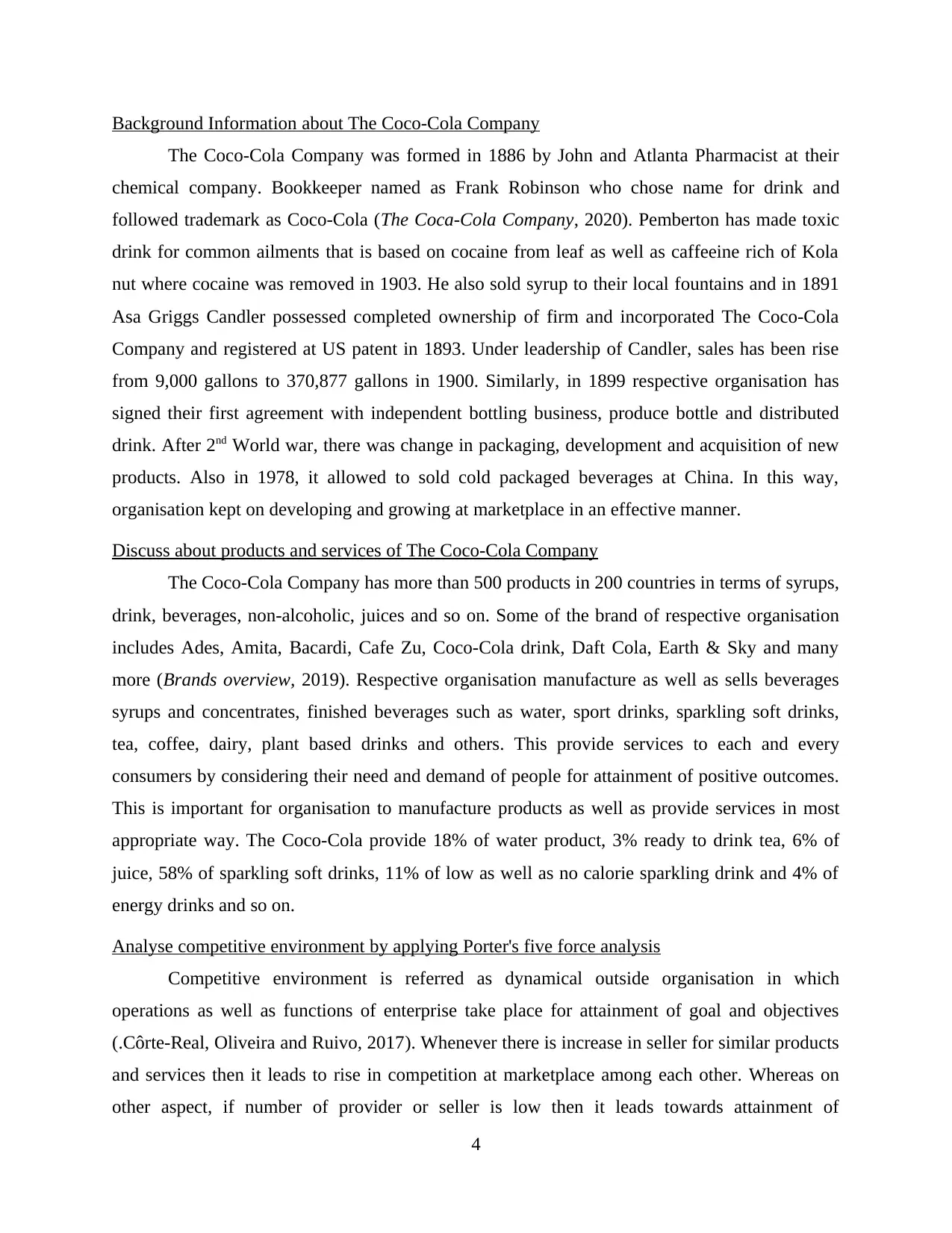
Background Information about The Coco-Cola Company
The Coco-Cola Company was formed in 1886 by John and Atlanta Pharmacist at their
chemical company. Bookkeeper named as Frank Robinson who chose name for drink and
followed trademark as Coco-Cola (The Coca-Cola Company, 2020). Pemberton has made toxic
drink for common ailments that is based on cocaine from leaf as well as caffeeine rich of Kola
nut where cocaine was removed in 1903. He also sold syrup to their local fountains and in 1891
Asa Griggs Candler possessed completed ownership of firm and incorporated The Coco-Cola
Company and registered at US patent in 1893. Under leadership of Candler, sales has been rise
from 9,000 gallons to 370,877 gallons in 1900. Similarly, in 1899 respective organisation has
signed their first agreement with independent bottling business, produce bottle and distributed
drink. After 2nd World war, there was change in packaging, development and acquisition of new
products. Also in 1978, it allowed to sold cold packaged beverages at China. In this way,
organisation kept on developing and growing at marketplace in an effective manner.
Discuss about products and services of The Coco-Cola Company
The Coco-Cola Company has more than 500 products in 200 countries in terms of syrups,
drink, beverages, non-alcoholic, juices and so on. Some of the brand of respective organisation
includes Ades, Amita, Bacardi, Cafe Zu, Coco-Cola drink, Daft Cola, Earth & Sky and many
more (Brands overview, 2019). Respective organisation manufacture as well as sells beverages
syrups and concentrates, finished beverages such as water, sport drinks, sparkling soft drinks,
tea, coffee, dairy, plant based drinks and others. This provide services to each and every
consumers by considering their need and demand of people for attainment of positive outcomes.
This is important for organisation to manufacture products as well as provide services in most
appropriate way. The Coco-Cola provide 18% of water product, 3% ready to drink tea, 6% of
juice, 58% of sparkling soft drinks, 11% of low as well as no calorie sparkling drink and 4% of
energy drinks and so on.
Analyse competitive environment by applying Porter's five force analysis
Competitive environment is referred as dynamical outside organisation in which
operations as well as functions of enterprise take place for attainment of goal and objectives
(.Côrte-Real, Oliveira and Ruivo, 2017). Whenever there is increase in seller for similar products
and services then it leads to rise in competition at marketplace among each other. Whereas on
other aspect, if number of provider or seller is low then it leads towards attainment of
4
The Coco-Cola Company was formed in 1886 by John and Atlanta Pharmacist at their
chemical company. Bookkeeper named as Frank Robinson who chose name for drink and
followed trademark as Coco-Cola (The Coca-Cola Company, 2020). Pemberton has made toxic
drink for common ailments that is based on cocaine from leaf as well as caffeeine rich of Kola
nut where cocaine was removed in 1903. He also sold syrup to their local fountains and in 1891
Asa Griggs Candler possessed completed ownership of firm and incorporated The Coco-Cola
Company and registered at US patent in 1893. Under leadership of Candler, sales has been rise
from 9,000 gallons to 370,877 gallons in 1900. Similarly, in 1899 respective organisation has
signed their first agreement with independent bottling business, produce bottle and distributed
drink. After 2nd World war, there was change in packaging, development and acquisition of new
products. Also in 1978, it allowed to sold cold packaged beverages at China. In this way,
organisation kept on developing and growing at marketplace in an effective manner.
Discuss about products and services of The Coco-Cola Company
The Coco-Cola Company has more than 500 products in 200 countries in terms of syrups,
drink, beverages, non-alcoholic, juices and so on. Some of the brand of respective organisation
includes Ades, Amita, Bacardi, Cafe Zu, Coco-Cola drink, Daft Cola, Earth & Sky and many
more (Brands overview, 2019). Respective organisation manufacture as well as sells beverages
syrups and concentrates, finished beverages such as water, sport drinks, sparkling soft drinks,
tea, coffee, dairy, plant based drinks and others. This provide services to each and every
consumers by considering their need and demand of people for attainment of positive outcomes.
This is important for organisation to manufacture products as well as provide services in most
appropriate way. The Coco-Cola provide 18% of water product, 3% ready to drink tea, 6% of
juice, 58% of sparkling soft drinks, 11% of low as well as no calorie sparkling drink and 4% of
energy drinks and so on.
Analyse competitive environment by applying Porter's five force analysis
Competitive environment is referred as dynamical outside organisation in which
operations as well as functions of enterprise take place for attainment of goal and objectives
(.Côrte-Real, Oliveira and Ruivo, 2017). Whenever there is increase in seller for similar products
and services then it leads to rise in competition at marketplace among each other. Whereas on
other aspect, if number of provider or seller is low then it leads towards attainment of
4
Secure Best Marks with AI Grader
Need help grading? Try our AI Grader for instant feedback on your assignments.
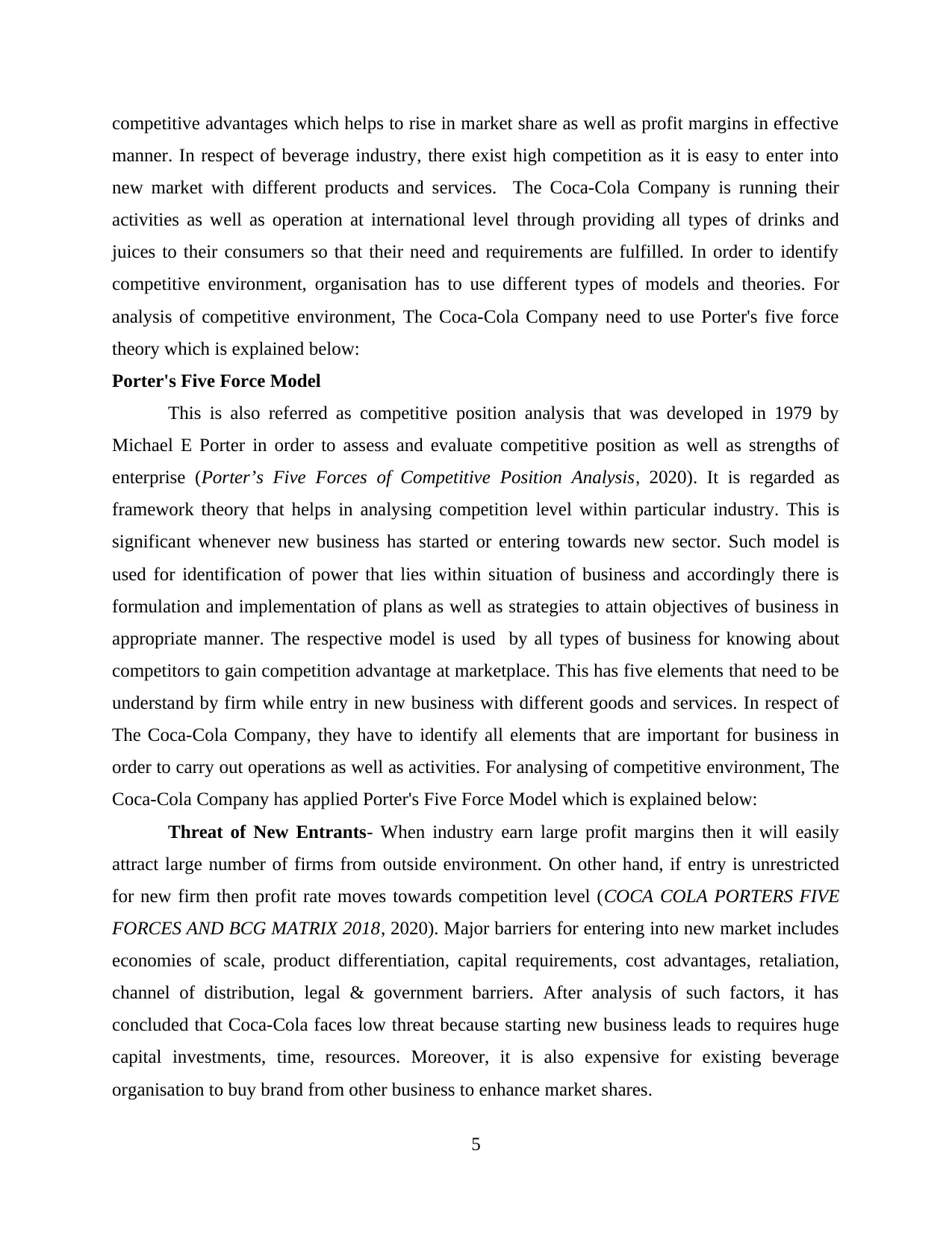
competitive advantages which helps to rise in market share as well as profit margins in effective
manner. In respect of beverage industry, there exist high competition as it is easy to enter into
new market with different products and services. The Coca-Cola Company is running their
activities as well as operation at international level through providing all types of drinks and
juices to their consumers so that their need and requirements are fulfilled. In order to identify
competitive environment, organisation has to use different types of models and theories. For
analysis of competitive environment, The Coca-Cola Company need to use Porter's five force
theory which is explained below:
Porter's Five Force Model
This is also referred as competitive position analysis that was developed in 1979 by
Michael E Porter in order to assess and evaluate competitive position as well as strengths of
enterprise (Porter’s Five Forces of Competitive Position Analysis, 2020). It is regarded as
framework theory that helps in analysing competition level within particular industry. This is
significant whenever new business has started or entering towards new sector. Such model is
used for identification of power that lies within situation of business and accordingly there is
formulation and implementation of plans as well as strategies to attain objectives of business in
appropriate manner. The respective model is used by all types of business for knowing about
competitors to gain competition advantage at marketplace. This has five elements that need to be
understand by firm while entry in new business with different goods and services. In respect of
The Coca-Cola Company, they have to identify all elements that are important for business in
order to carry out operations as well as activities. For analysing of competitive environment, The
Coca-Cola Company has applied Porter's Five Force Model which is explained below:
Threat of New Entrants- When industry earn large profit margins then it will easily
attract large number of firms from outside environment. On other hand, if entry is unrestricted
for new firm then profit rate moves towards competition level (COCA COLA PORTERS FIVE
FORCES AND BCG MATRIX 2018, 2020). Major barriers for entering into new market includes
economies of scale, product differentiation, capital requirements, cost advantages, retaliation,
channel of distribution, legal & government barriers. After analysis of such factors, it has
concluded that Coca-Cola faces low threat because starting new business leads to requires huge
capital investments, time, resources. Moreover, it is also expensive for existing beverage
organisation to buy brand from other business to enhance market shares.
5
manner. In respect of beverage industry, there exist high competition as it is easy to enter into
new market with different products and services. The Coca-Cola Company is running their
activities as well as operation at international level through providing all types of drinks and
juices to their consumers so that their need and requirements are fulfilled. In order to identify
competitive environment, organisation has to use different types of models and theories. For
analysis of competitive environment, The Coca-Cola Company need to use Porter's five force
theory which is explained below:
Porter's Five Force Model
This is also referred as competitive position analysis that was developed in 1979 by
Michael E Porter in order to assess and evaluate competitive position as well as strengths of
enterprise (Porter’s Five Forces of Competitive Position Analysis, 2020). It is regarded as
framework theory that helps in analysing competition level within particular industry. This is
significant whenever new business has started or entering towards new sector. Such model is
used for identification of power that lies within situation of business and accordingly there is
formulation and implementation of plans as well as strategies to attain objectives of business in
appropriate manner. The respective model is used by all types of business for knowing about
competitors to gain competition advantage at marketplace. This has five elements that need to be
understand by firm while entry in new business with different goods and services. In respect of
The Coca-Cola Company, they have to identify all elements that are important for business in
order to carry out operations as well as activities. For analysing of competitive environment, The
Coca-Cola Company has applied Porter's Five Force Model which is explained below:
Threat of New Entrants- When industry earn large profit margins then it will easily
attract large number of firms from outside environment. On other hand, if entry is unrestricted
for new firm then profit rate moves towards competition level (COCA COLA PORTERS FIVE
FORCES AND BCG MATRIX 2018, 2020). Major barriers for entering into new market includes
economies of scale, product differentiation, capital requirements, cost advantages, retaliation,
channel of distribution, legal & government barriers. After analysis of such factors, it has
concluded that Coca-Cola faces low threat because starting new business leads to requires huge
capital investments, time, resources. Moreover, it is also expensive for existing beverage
organisation to buy brand from other business to enhance market shares.
5
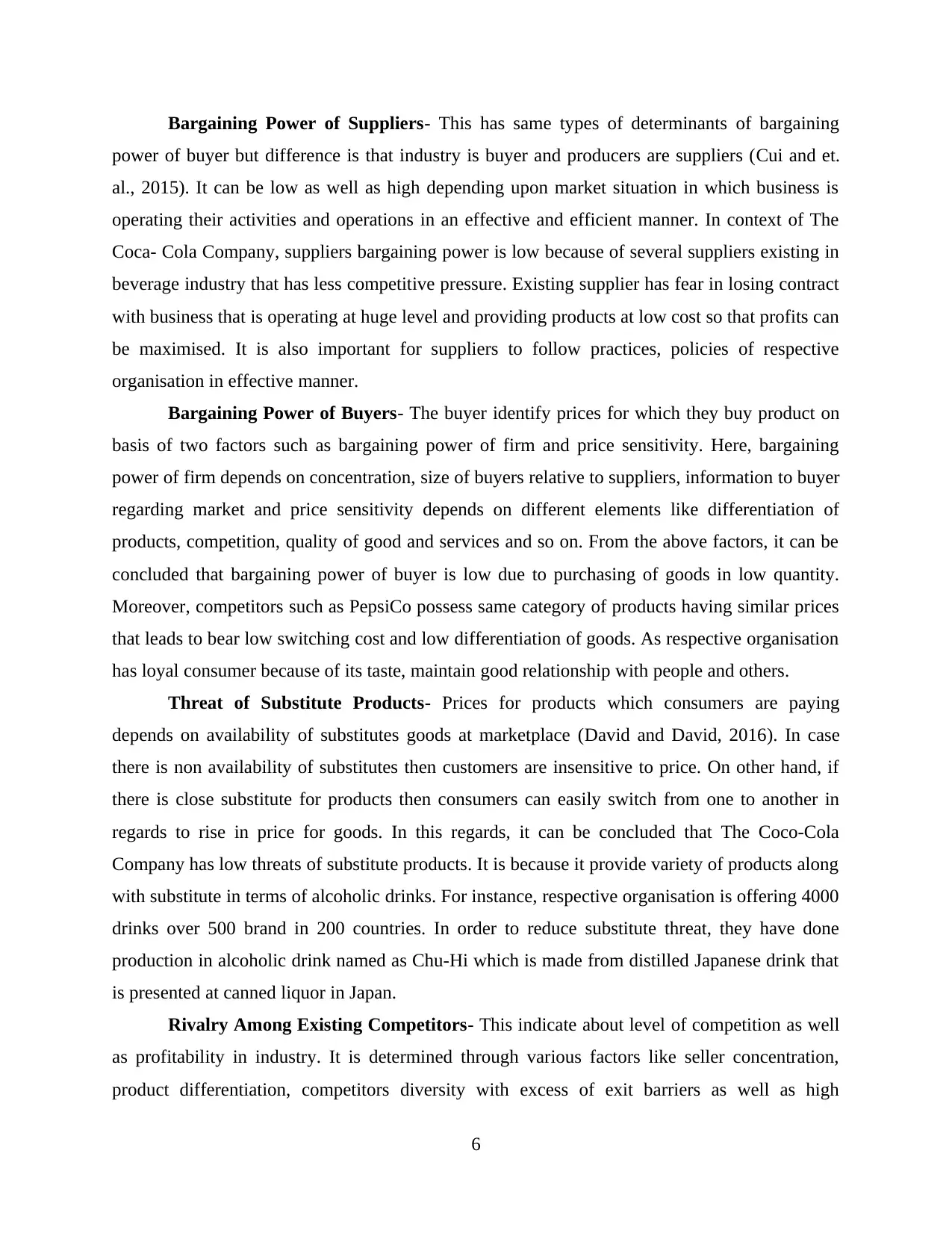
Bargaining Power of Suppliers- This has same types of determinants of bargaining
power of buyer but difference is that industry is buyer and producers are suppliers (Cui and et.
al., 2015). It can be low as well as high depending upon market situation in which business is
operating their activities and operations in an effective and efficient manner. In context of The
Coca- Cola Company, suppliers bargaining power is low because of several suppliers existing in
beverage industry that has less competitive pressure. Existing supplier has fear in losing contract
with business that is operating at huge level and providing products at low cost so that profits can
be maximised. It is also important for suppliers to follow practices, policies of respective
organisation in effective manner.
Bargaining Power of Buyers- The buyer identify prices for which they buy product on
basis of two factors such as bargaining power of firm and price sensitivity. Here, bargaining
power of firm depends on concentration, size of buyers relative to suppliers, information to buyer
regarding market and price sensitivity depends on different elements like differentiation of
products, competition, quality of good and services and so on. From the above factors, it can be
concluded that bargaining power of buyer is low due to purchasing of goods in low quantity.
Moreover, competitors such as PepsiCo possess same category of products having similar prices
that leads to bear low switching cost and low differentiation of goods. As respective organisation
has loyal consumer because of its taste, maintain good relationship with people and others.
Threat of Substitute Products- Prices for products which consumers are paying
depends on availability of substitutes goods at marketplace (David and David, 2016). In case
there is non availability of substitutes then customers are insensitive to price. On other hand, if
there is close substitute for products then consumers can easily switch from one to another in
regards to rise in price for goods. In this regards, it can be concluded that The Coco-Cola
Company has low threats of substitute products. It is because it provide variety of products along
with substitute in terms of alcoholic drinks. For instance, respective organisation is offering 4000
drinks over 500 brand in 200 countries. In order to reduce substitute threat, they have done
production in alcoholic drink named as Chu-Hi which is made from distilled Japanese drink that
is presented at canned liquor in Japan.
Rivalry Among Existing Competitors- This indicate about level of competition as well
as profitability in industry. It is determined through various factors like seller concentration,
product differentiation, competitors diversity with excess of exit barriers as well as high
6
power of buyer but difference is that industry is buyer and producers are suppliers (Cui and et.
al., 2015). It can be low as well as high depending upon market situation in which business is
operating their activities and operations in an effective and efficient manner. In context of The
Coca- Cola Company, suppliers bargaining power is low because of several suppliers existing in
beverage industry that has less competitive pressure. Existing supplier has fear in losing contract
with business that is operating at huge level and providing products at low cost so that profits can
be maximised. It is also important for suppliers to follow practices, policies of respective
organisation in effective manner.
Bargaining Power of Buyers- The buyer identify prices for which they buy product on
basis of two factors such as bargaining power of firm and price sensitivity. Here, bargaining
power of firm depends on concentration, size of buyers relative to suppliers, information to buyer
regarding market and price sensitivity depends on different elements like differentiation of
products, competition, quality of good and services and so on. From the above factors, it can be
concluded that bargaining power of buyer is low due to purchasing of goods in low quantity.
Moreover, competitors such as PepsiCo possess same category of products having similar prices
that leads to bear low switching cost and low differentiation of goods. As respective organisation
has loyal consumer because of its taste, maintain good relationship with people and others.
Threat of Substitute Products- Prices for products which consumers are paying
depends on availability of substitutes goods at marketplace (David and David, 2016). In case
there is non availability of substitutes then customers are insensitive to price. On other hand, if
there is close substitute for products then consumers can easily switch from one to another in
regards to rise in price for goods. In this regards, it can be concluded that The Coco-Cola
Company has low threats of substitute products. It is because it provide variety of products along
with substitute in terms of alcoholic drinks. For instance, respective organisation is offering 4000
drinks over 500 brand in 200 countries. In order to reduce substitute threat, they have done
production in alcoholic drink named as Chu-Hi which is made from distilled Japanese drink that
is presented at canned liquor in Japan.
Rivalry Among Existing Competitors- This indicate about level of competition as well
as profitability in industry. It is determined through various factors like seller concentration,
product differentiation, competitors diversity with excess of exit barriers as well as high
6
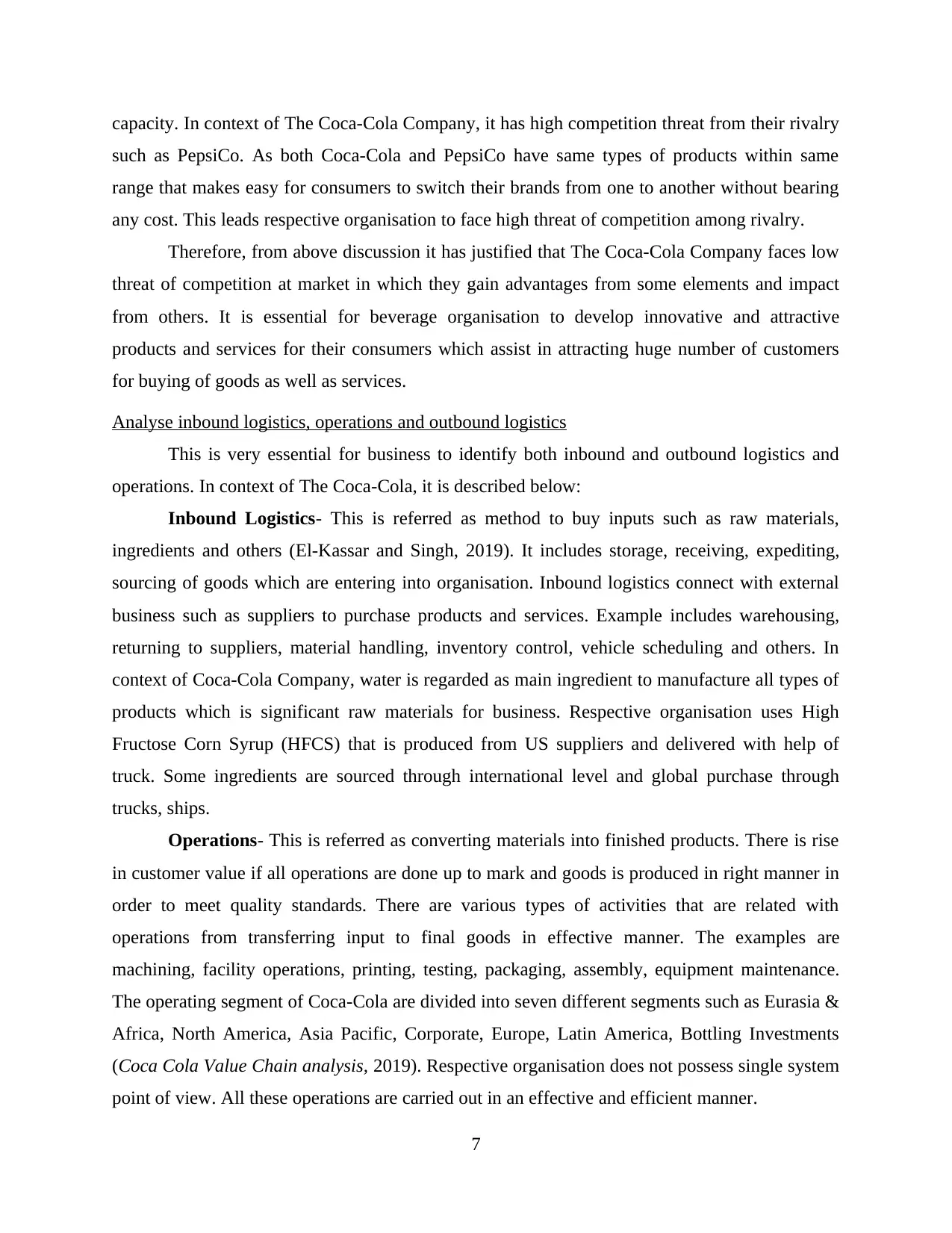
capacity. In context of The Coca-Cola Company, it has high competition threat from their rivalry
such as PepsiCo. As both Coca-Cola and PepsiCo have same types of products within same
range that makes easy for consumers to switch their brands from one to another without bearing
any cost. This leads respective organisation to face high threat of competition among rivalry.
Therefore, from above discussion it has justified that The Coca-Cola Company faces low
threat of competition at market in which they gain advantages from some elements and impact
from others. It is essential for beverage organisation to develop innovative and attractive
products and services for their consumers which assist in attracting huge number of customers
for buying of goods as well as services.
Analyse inbound logistics, operations and outbound logistics
This is very essential for business to identify both inbound and outbound logistics and
operations. In context of The Coca-Cola, it is described below:
Inbound Logistics- This is referred as method to buy inputs such as raw materials,
ingredients and others (El-Kassar and Singh, 2019). It includes storage, receiving, expediting,
sourcing of goods which are entering into organisation. Inbound logistics connect with external
business such as suppliers to purchase products and services. Example includes warehousing,
returning to suppliers, material handling, inventory control, vehicle scheduling and others. In
context of Coca-Cola Company, water is regarded as main ingredient to manufacture all types of
products which is significant raw materials for business. Respective organisation uses High
Fructose Corn Syrup (HFCS) that is produced from US suppliers and delivered with help of
truck. Some ingredients are sourced through international level and global purchase through
trucks, ships.
Operations- This is referred as converting materials into finished products. There is rise
in customer value if all operations are done up to mark and goods is produced in right manner in
order to meet quality standards. There are various types of activities that are related with
operations from transferring input to final goods in effective manner. The examples are
machining, facility operations, printing, testing, packaging, assembly, equipment maintenance.
The operating segment of Coca-Cola are divided into seven different segments such as Eurasia &
Africa, North America, Asia Pacific, Corporate, Europe, Latin America, Bottling Investments
(Coca Cola Value Chain analysis, 2019). Respective organisation does not possess single system
point of view. All these operations are carried out in an effective and efficient manner.
7
such as PepsiCo. As both Coca-Cola and PepsiCo have same types of products within same
range that makes easy for consumers to switch their brands from one to another without bearing
any cost. This leads respective organisation to face high threat of competition among rivalry.
Therefore, from above discussion it has justified that The Coca-Cola Company faces low
threat of competition at market in which they gain advantages from some elements and impact
from others. It is essential for beverage organisation to develop innovative and attractive
products and services for their consumers which assist in attracting huge number of customers
for buying of goods as well as services.
Analyse inbound logistics, operations and outbound logistics
This is very essential for business to identify both inbound and outbound logistics and
operations. In context of The Coca-Cola, it is described below:
Inbound Logistics- This is referred as method to buy inputs such as raw materials,
ingredients and others (El-Kassar and Singh, 2019). It includes storage, receiving, expediting,
sourcing of goods which are entering into organisation. Inbound logistics connect with external
business such as suppliers to purchase products and services. Example includes warehousing,
returning to suppliers, material handling, inventory control, vehicle scheduling and others. In
context of Coca-Cola Company, water is regarded as main ingredient to manufacture all types of
products which is significant raw materials for business. Respective organisation uses High
Fructose Corn Syrup (HFCS) that is produced from US suppliers and delivered with help of
truck. Some ingredients are sourced through international level and global purchase through
trucks, ships.
Operations- This is referred as converting materials into finished products. There is rise
in customer value if all operations are done up to mark and goods is produced in right manner in
order to meet quality standards. There are various types of activities that are related with
operations from transferring input to final goods in effective manner. The examples are
machining, facility operations, printing, testing, packaging, assembly, equipment maintenance.
The operating segment of Coca-Cola are divided into seven different segments such as Eurasia &
Africa, North America, Asia Pacific, Corporate, Europe, Latin America, Bottling Investments
(Coca Cola Value Chain analysis, 2019). Respective organisation does not possess single system
point of view. All these operations are carried out in an effective and efficient manner.
7
Paraphrase This Document
Need a fresh take? Get an instant paraphrase of this document with our AI Paraphraser
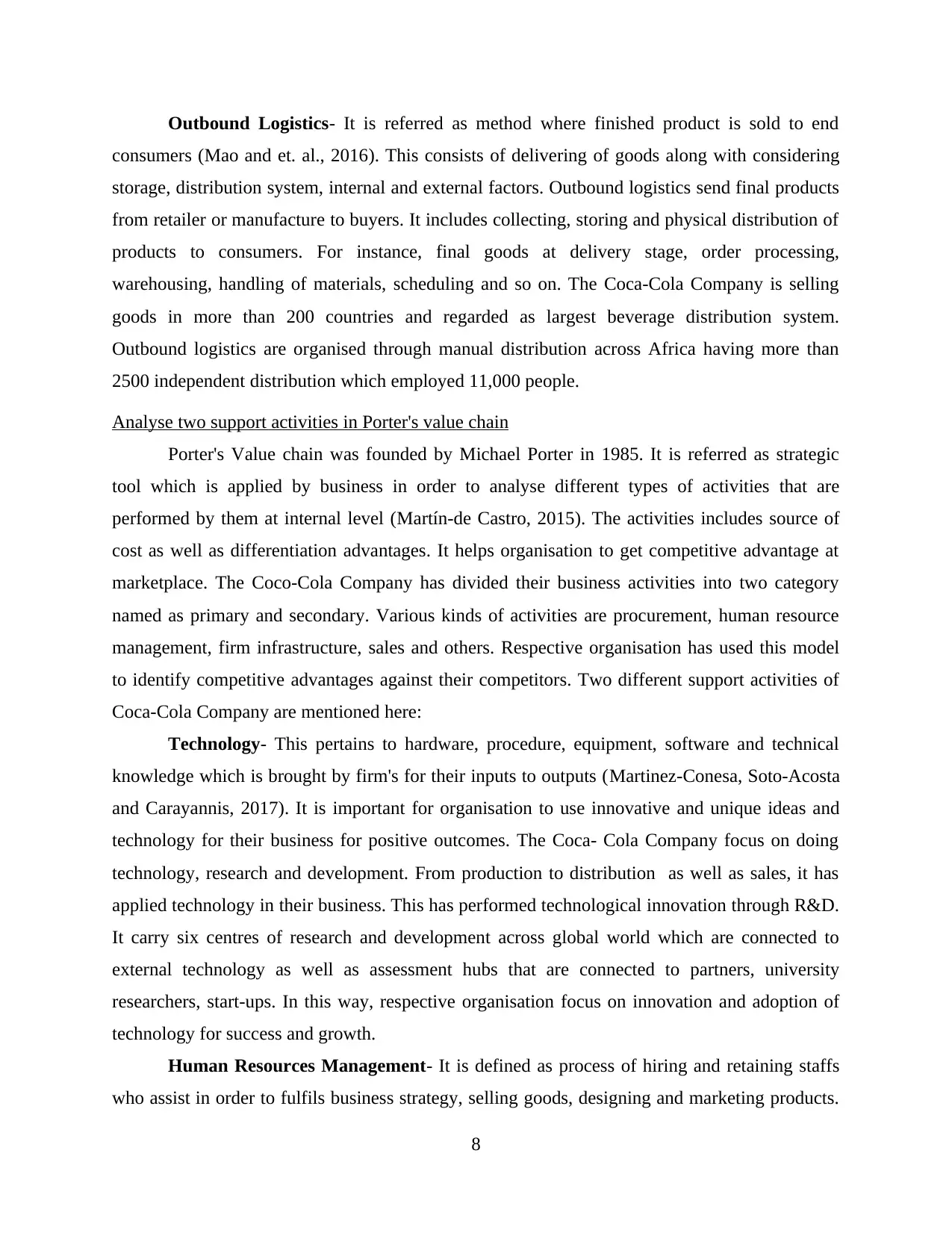
Outbound Logistics- It is referred as method where finished product is sold to end
consumers (Mao and et. al., 2016). This consists of delivering of goods along with considering
storage, distribution system, internal and external factors. Outbound logistics send final products
from retailer or manufacture to buyers. It includes collecting, storing and physical distribution of
products to consumers. For instance, final goods at delivery stage, order processing,
warehousing, handling of materials, scheduling and so on. The Coca-Cola Company is selling
goods in more than 200 countries and regarded as largest beverage distribution system.
Outbound logistics are organised through manual distribution across Africa having more than
2500 independent distribution which employed 11,000 people.
Analyse two support activities in Porter's value chain
Porter's Value chain was founded by Michael Porter in 1985. It is referred as strategic
tool which is applied by business in order to analyse different types of activities that are
performed by them at internal level (Martín-de Castro, 2015). The activities includes source of
cost as well as differentiation advantages. It helps organisation to get competitive advantage at
marketplace. The Coco-Cola Company has divided their business activities into two category
named as primary and secondary. Various kinds of activities are procurement, human resource
management, firm infrastructure, sales and others. Respective organisation has used this model
to identify competitive advantages against their competitors. Two different support activities of
Coca-Cola Company are mentioned here:
Technology- This pertains to hardware, procedure, equipment, software and technical
knowledge which is brought by firm's for their inputs to outputs (Martinez-Conesa, Soto-Acosta
and Carayannis, 2017). It is important for organisation to use innovative and unique ideas and
technology for their business for positive outcomes. The Coca- Cola Company focus on doing
technology, research and development. From production to distribution as well as sales, it has
applied technology in their business. This has performed technological innovation through R&D.
It carry six centres of research and development across global world which are connected to
external technology as well as assessment hubs that are connected to partners, university
researchers, start-ups. In this way, respective organisation focus on innovation and adoption of
technology for success and growth.
Human Resources Management- It is defined as process of hiring and retaining staffs
who assist in order to fulfils business strategy, selling goods, designing and marketing products.
8
consumers (Mao and et. al., 2016). This consists of delivering of goods along with considering
storage, distribution system, internal and external factors. Outbound logistics send final products
from retailer or manufacture to buyers. It includes collecting, storing and physical distribution of
products to consumers. For instance, final goods at delivery stage, order processing,
warehousing, handling of materials, scheduling and so on. The Coca-Cola Company is selling
goods in more than 200 countries and regarded as largest beverage distribution system.
Outbound logistics are organised through manual distribution across Africa having more than
2500 independent distribution which employed 11,000 people.
Analyse two support activities in Porter's value chain
Porter's Value chain was founded by Michael Porter in 1985. It is referred as strategic
tool which is applied by business in order to analyse different types of activities that are
performed by them at internal level (Martín-de Castro, 2015). The activities includes source of
cost as well as differentiation advantages. It helps organisation to get competitive advantage at
marketplace. The Coco-Cola Company has divided their business activities into two category
named as primary and secondary. Various kinds of activities are procurement, human resource
management, firm infrastructure, sales and others. Respective organisation has used this model
to identify competitive advantages against their competitors. Two different support activities of
Coca-Cola Company are mentioned here:
Technology- This pertains to hardware, procedure, equipment, software and technical
knowledge which is brought by firm's for their inputs to outputs (Martinez-Conesa, Soto-Acosta
and Carayannis, 2017). It is important for organisation to use innovative and unique ideas and
technology for their business for positive outcomes. The Coca- Cola Company focus on doing
technology, research and development. From production to distribution as well as sales, it has
applied technology in their business. This has performed technological innovation through R&D.
It carry six centres of research and development across global world which are connected to
external technology as well as assessment hubs that are connected to partners, university
researchers, start-ups. In this way, respective organisation focus on innovation and adoption of
technology for success and growth.
Human Resources Management- It is defined as process of hiring and retaining staffs
who assist in order to fulfils business strategy, selling goods, designing and marketing products.
8

This is essential to hire skilled and capable employees for business to perform sales, operation,
logistics, marketing and many more activities. Respective organisation focus on hiring skilled
and capable talent and workforce to create environment of growth as well as learning. They pay
them salary, wages, incentives and rewards. Moreover, Coca-Cola Company also consider
engagement and employee motivation.
Thus, these above mentioned are regarded as important support activities that has to be
adopted by Coco-Cola Company in appropriate manner. This lead to achieve business goal and
objectives in best manner.
Identify key value adding activities with justification
Value adding activities are defined as such action that helps in providing benefits to
consumers in terms of goods and services (Mikalef and Pateli, 2017). This is important for
business to analyse as well as determine all those activities that helps in adding value to customer
and meeting their expectation. Some of key value adding activities in respect of Coca-Cola
Company are described here:
The Coco-Cola Company should focus on designing products on regular basis for
attracting large number of consumers to rise brand value, goodwill and loyalty (Nguyen,
Newby and Macaulay, 2015). It assist in creation of motivation, satisfaction to all
employees and customers of business. This will helps user to get innovative and attractive
designing of products such as drinks, juices and so on.
The Coco-Cola Company need to rise promotional tools and techniques that helps in
attracting large number of consumers from global, local and national level. This leads to
rise in market share, profitability ratio and sales of business. Moreover, they have to
adopt techniques like Instagram, Facebook, YouTube, digital media and others.
Therefore, with the consideration of all value adding activities, respective organisation
can easily provide premium quality of products as well as services to their consumers through
fulfilment of their requirement in order to meet their expectation.
Business could deploy information technology, innovative idea for enhancing competitive
position
The different types of innovative ideas as well as information technology that are adopted
by Coca-Cola Company for achieving competitive advantage at marketplace are described
below:
9
logistics, marketing and many more activities. Respective organisation focus on hiring skilled
and capable talent and workforce to create environment of growth as well as learning. They pay
them salary, wages, incentives and rewards. Moreover, Coca-Cola Company also consider
engagement and employee motivation.
Thus, these above mentioned are regarded as important support activities that has to be
adopted by Coco-Cola Company in appropriate manner. This lead to achieve business goal and
objectives in best manner.
Identify key value adding activities with justification
Value adding activities are defined as such action that helps in providing benefits to
consumers in terms of goods and services (Mikalef and Pateli, 2017). This is important for
business to analyse as well as determine all those activities that helps in adding value to customer
and meeting their expectation. Some of key value adding activities in respect of Coca-Cola
Company are described here:
The Coco-Cola Company should focus on designing products on regular basis for
attracting large number of consumers to rise brand value, goodwill and loyalty (Nguyen,
Newby and Macaulay, 2015). It assist in creation of motivation, satisfaction to all
employees and customers of business. This will helps user to get innovative and attractive
designing of products such as drinks, juices and so on.
The Coco-Cola Company need to rise promotional tools and techniques that helps in
attracting large number of consumers from global, local and national level. This leads to
rise in market share, profitability ratio and sales of business. Moreover, they have to
adopt techniques like Instagram, Facebook, YouTube, digital media and others.
Therefore, with the consideration of all value adding activities, respective organisation
can easily provide premium quality of products as well as services to their consumers through
fulfilment of their requirement in order to meet their expectation.
Business could deploy information technology, innovative idea for enhancing competitive
position
The different types of innovative ideas as well as information technology that are adopted
by Coca-Cola Company for achieving competitive advantage at marketplace are described
below:
9
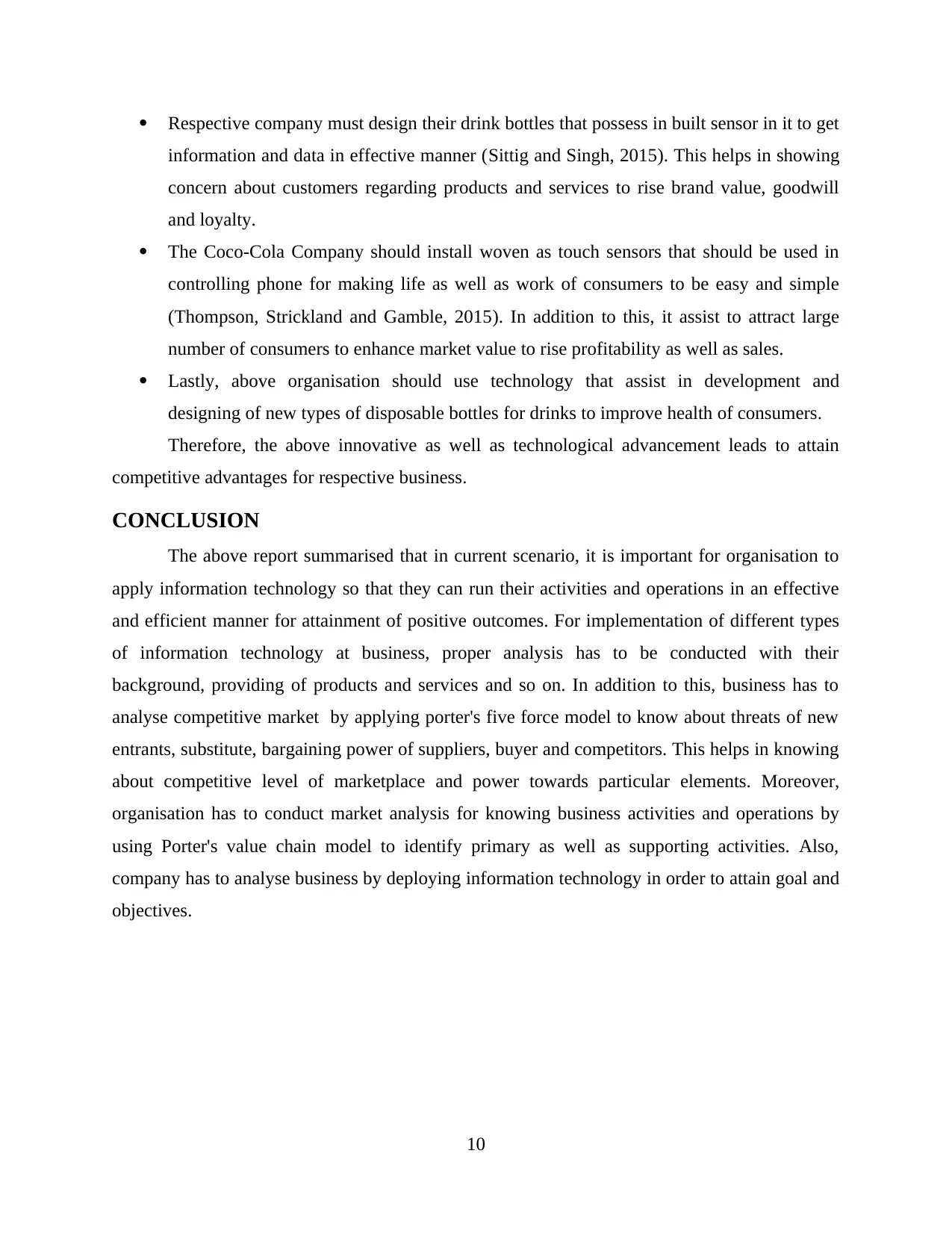
Respective company must design their drink bottles that possess in built sensor in it to get
information and data in effective manner (Sittig and Singh, 2015). This helps in showing
concern about customers regarding products and services to rise brand value, goodwill
and loyalty.
The Coco-Cola Company should install woven as touch sensors that should be used in
controlling phone for making life as well as work of consumers to be easy and simple
(Thompson, Strickland and Gamble, 2015). In addition to this, it assist to attract large
number of consumers to enhance market value to rise profitability as well as sales.
Lastly, above organisation should use technology that assist in development and
designing of new types of disposable bottles for drinks to improve health of consumers.
Therefore, the above innovative as well as technological advancement leads to attain
competitive advantages for respective business.
CONCLUSION
The above report summarised that in current scenario, it is important for organisation to
apply information technology so that they can run their activities and operations in an effective
and efficient manner for attainment of positive outcomes. For implementation of different types
of information technology at business, proper analysis has to be conducted with their
background, providing of products and services and so on. In addition to this, business has to
analyse competitive market by applying porter's five force model to know about threats of new
entrants, substitute, bargaining power of suppliers, buyer and competitors. This helps in knowing
about competitive level of marketplace and power towards particular elements. Moreover,
organisation has to conduct market analysis for knowing business activities and operations by
using Porter's value chain model to identify primary as well as supporting activities. Also,
company has to analyse business by deploying information technology in order to attain goal and
objectives.
10
information and data in effective manner (Sittig and Singh, 2015). This helps in showing
concern about customers regarding products and services to rise brand value, goodwill
and loyalty.
The Coco-Cola Company should install woven as touch sensors that should be used in
controlling phone for making life as well as work of consumers to be easy and simple
(Thompson, Strickland and Gamble, 2015). In addition to this, it assist to attract large
number of consumers to enhance market value to rise profitability as well as sales.
Lastly, above organisation should use technology that assist in development and
designing of new types of disposable bottles for drinks to improve health of consumers.
Therefore, the above innovative as well as technological advancement leads to attain
competitive advantages for respective business.
CONCLUSION
The above report summarised that in current scenario, it is important for organisation to
apply information technology so that they can run their activities and operations in an effective
and efficient manner for attainment of positive outcomes. For implementation of different types
of information technology at business, proper analysis has to be conducted with their
background, providing of products and services and so on. In addition to this, business has to
analyse competitive market by applying porter's five force model to know about threats of new
entrants, substitute, bargaining power of suppliers, buyer and competitors. This helps in knowing
about competitive level of marketplace and power towards particular elements. Moreover,
organisation has to conduct market analysis for knowing business activities and operations by
using Porter's value chain model to identify primary as well as supporting activities. Also,
company has to analyse business by deploying information technology in order to attain goal and
objectives.
10
Secure Best Marks with AI Grader
Need help grading? Try our AI Grader for instant feedback on your assignments.
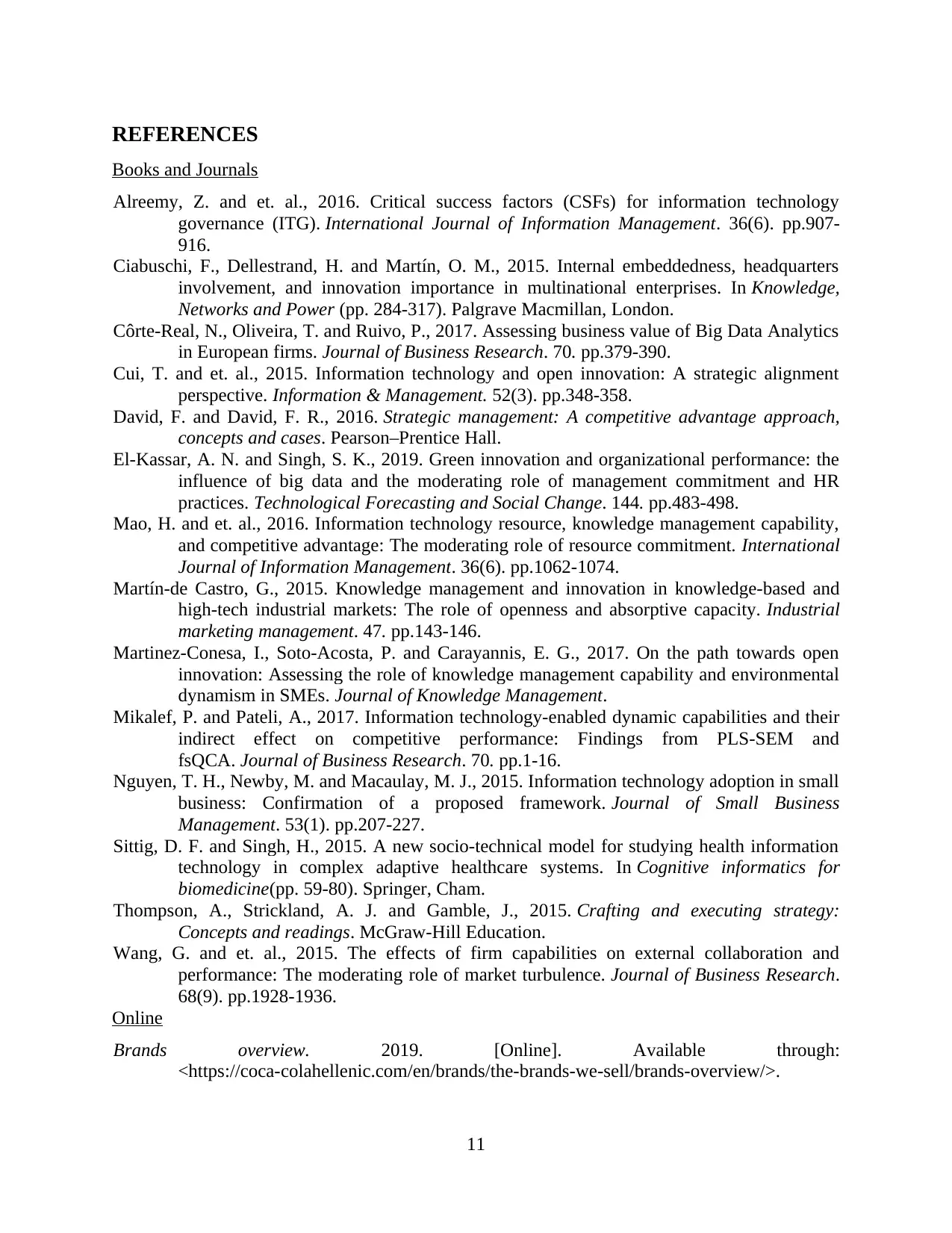
REFERENCES
Books and Journals
Alreemy, Z. and et. al., 2016. Critical success factors (CSFs) for information technology
governance (ITG). International Journal of Information Management. 36(6). pp.907-
916.
Ciabuschi, F., Dellestrand, H. and Martín, O. M., 2015. Internal embeddedness, headquarters
involvement, and innovation importance in multinational enterprises. In Knowledge,
Networks and Power (pp. 284-317). Palgrave Macmillan, London.
Côrte-Real, N., Oliveira, T. and Ruivo, P., 2017. Assessing business value of Big Data Analytics
in European firms. Journal of Business Research. 70. pp.379-390.
Cui, T. and et. al., 2015. Information technology and open innovation: A strategic alignment
perspective. Information & Management. 52(3). pp.348-358.
David, F. and David, F. R., 2016. Strategic management: A competitive advantage approach,
concepts and cases. Pearson–Prentice Hall.
El-Kassar, A. N. and Singh, S. K., 2019. Green innovation and organizational performance: the
influence of big data and the moderating role of management commitment and HR
practices. Technological Forecasting and Social Change. 144. pp.483-498.
Mao, H. and et. al., 2016. Information technology resource, knowledge management capability,
and competitive advantage: The moderating role of resource commitment. International
Journal of Information Management. 36(6). pp.1062-1074.
Martín-de Castro, G., 2015. Knowledge management and innovation in knowledge-based and
high-tech industrial markets: The role of openness and absorptive capacity. Industrial
marketing management. 47. pp.143-146.
Martinez-Conesa, I., Soto-Acosta, P. and Carayannis, E. G., 2017. On the path towards open
innovation: Assessing the role of knowledge management capability and environmental
dynamism in SMEs. Journal of Knowledge Management.
Mikalef, P. and Pateli, A., 2017. Information technology-enabled dynamic capabilities and their
indirect effect on competitive performance: Findings from PLS-SEM and
fsQCA. Journal of Business Research. 70. pp.1-16.
Nguyen, T. H., Newby, M. and Macaulay, M. J., 2015. Information technology adoption in small
business: Confirmation of a proposed framework. Journal of Small Business
Management. 53(1). pp.207-227.
Sittig, D. F. and Singh, H., 2015. A new socio-technical model for studying health information
technology in complex adaptive healthcare systems. In Cognitive informatics for
biomedicine(pp. 59-80). Springer, Cham.
Thompson, A., Strickland, A. J. and Gamble, J., 2015. Crafting and executing strategy:
Concepts and readings. McGraw-Hill Education.
Wang, G. and et. al., 2015. The effects of firm capabilities on external collaboration and
performance: The moderating role of market turbulence. Journal of Business Research.
68(9). pp.1928-1936.
Online
Brands overview. 2019. [Online]. Available through:
<https://coca-colahellenic.com/en/brands/the-brands-we-sell/brands-overview/>.
11
Books and Journals
Alreemy, Z. and et. al., 2016. Critical success factors (CSFs) for information technology
governance (ITG). International Journal of Information Management. 36(6). pp.907-
916.
Ciabuschi, F., Dellestrand, H. and Martín, O. M., 2015. Internal embeddedness, headquarters
involvement, and innovation importance in multinational enterprises. In Knowledge,
Networks and Power (pp. 284-317). Palgrave Macmillan, London.
Côrte-Real, N., Oliveira, T. and Ruivo, P., 2017. Assessing business value of Big Data Analytics
in European firms. Journal of Business Research. 70. pp.379-390.
Cui, T. and et. al., 2015. Information technology and open innovation: A strategic alignment
perspective. Information & Management. 52(3). pp.348-358.
David, F. and David, F. R., 2016. Strategic management: A competitive advantage approach,
concepts and cases. Pearson–Prentice Hall.
El-Kassar, A. N. and Singh, S. K., 2019. Green innovation and organizational performance: the
influence of big data and the moderating role of management commitment and HR
practices. Technological Forecasting and Social Change. 144. pp.483-498.
Mao, H. and et. al., 2016. Information technology resource, knowledge management capability,
and competitive advantage: The moderating role of resource commitment. International
Journal of Information Management. 36(6). pp.1062-1074.
Martín-de Castro, G., 2015. Knowledge management and innovation in knowledge-based and
high-tech industrial markets: The role of openness and absorptive capacity. Industrial
marketing management. 47. pp.143-146.
Martinez-Conesa, I., Soto-Acosta, P. and Carayannis, E. G., 2017. On the path towards open
innovation: Assessing the role of knowledge management capability and environmental
dynamism in SMEs. Journal of Knowledge Management.
Mikalef, P. and Pateli, A., 2017. Information technology-enabled dynamic capabilities and their
indirect effect on competitive performance: Findings from PLS-SEM and
fsQCA. Journal of Business Research. 70. pp.1-16.
Nguyen, T. H., Newby, M. and Macaulay, M. J., 2015. Information technology adoption in small
business: Confirmation of a proposed framework. Journal of Small Business
Management. 53(1). pp.207-227.
Sittig, D. F. and Singh, H., 2015. A new socio-technical model for studying health information
technology in complex adaptive healthcare systems. In Cognitive informatics for
biomedicine(pp. 59-80). Springer, Cham.
Thompson, A., Strickland, A. J. and Gamble, J., 2015. Crafting and executing strategy:
Concepts and readings. McGraw-Hill Education.
Wang, G. and et. al., 2015. The effects of firm capabilities on external collaboration and
performance: The moderating role of market turbulence. Journal of Business Research.
68(9). pp.1928-1936.
Online
Brands overview. 2019. [Online]. Available through:
<https://coca-colahellenic.com/en/brands/the-brands-we-sell/brands-overview/>.
11
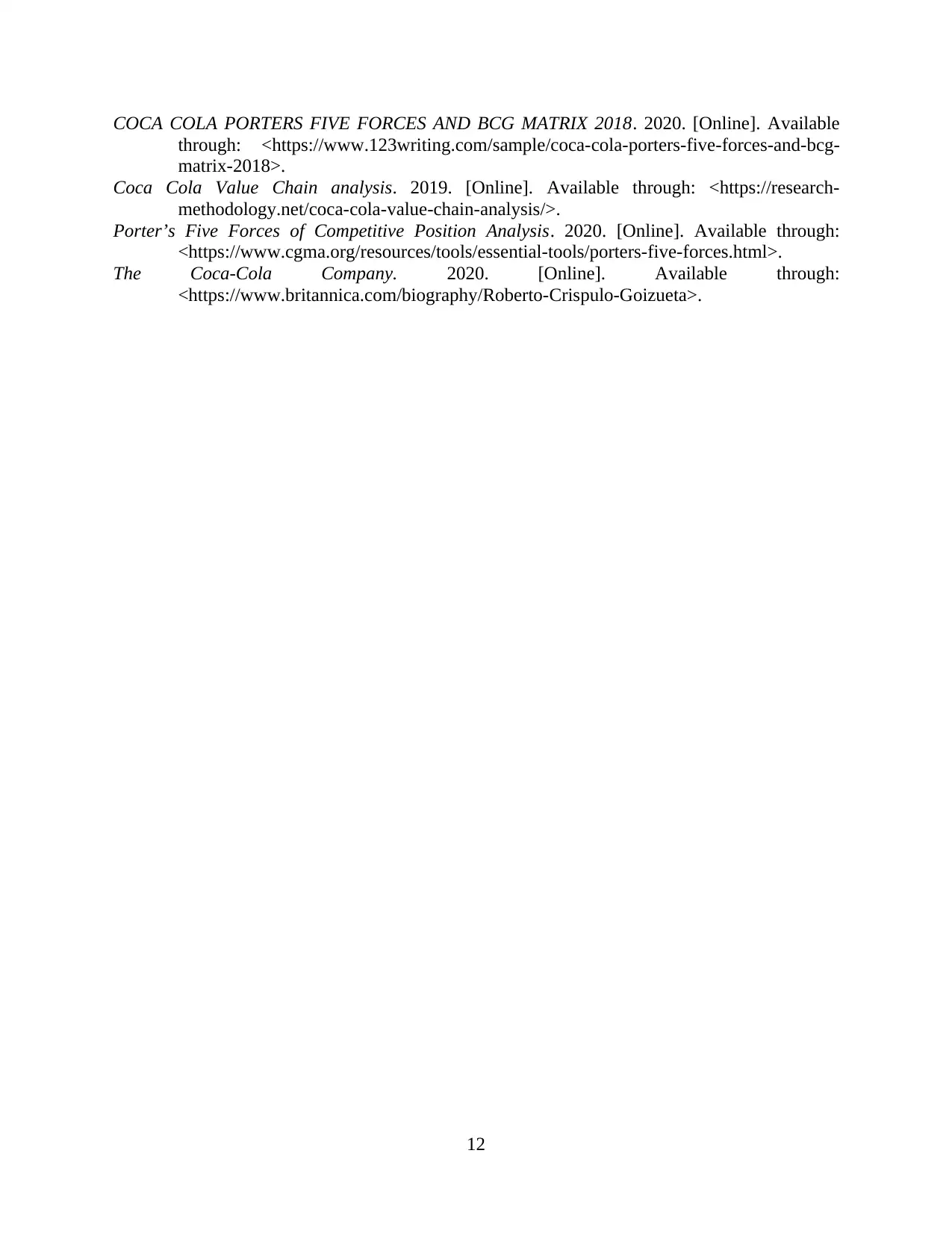
COCA COLA PORTERS FIVE FORCES AND BCG MATRIX 2018. 2020. [Online]. Available
through: <https://www.123writing.com/sample/coca-cola-porters-five-forces-and-bcg-
matrix-2018>.
Coca Cola Value Chain analysis. 2019. [Online]. Available through: <https://research-
methodology.net/coca-cola-value-chain-analysis/>.
Porter’s Five Forces of Competitive Position Analysis. 2020. [Online]. Available through:
<https://www.cgma.org/resources/tools/essential-tools/porters-five-forces.html>.
The Coca-Cola Company. 2020. [Online]. Available through:
<https://www.britannica.com/biography/Roberto-Crispulo-Goizueta>.
12
through: <https://www.123writing.com/sample/coca-cola-porters-five-forces-and-bcg-
matrix-2018>.
Coca Cola Value Chain analysis. 2019. [Online]. Available through: <https://research-
methodology.net/coca-cola-value-chain-analysis/>.
Porter’s Five Forces of Competitive Position Analysis. 2020. [Online]. Available through:
<https://www.cgma.org/resources/tools/essential-tools/porters-five-forces.html>.
The Coca-Cola Company. 2020. [Online]. Available through:
<https://www.britannica.com/biography/Roberto-Crispulo-Goizueta>.
12
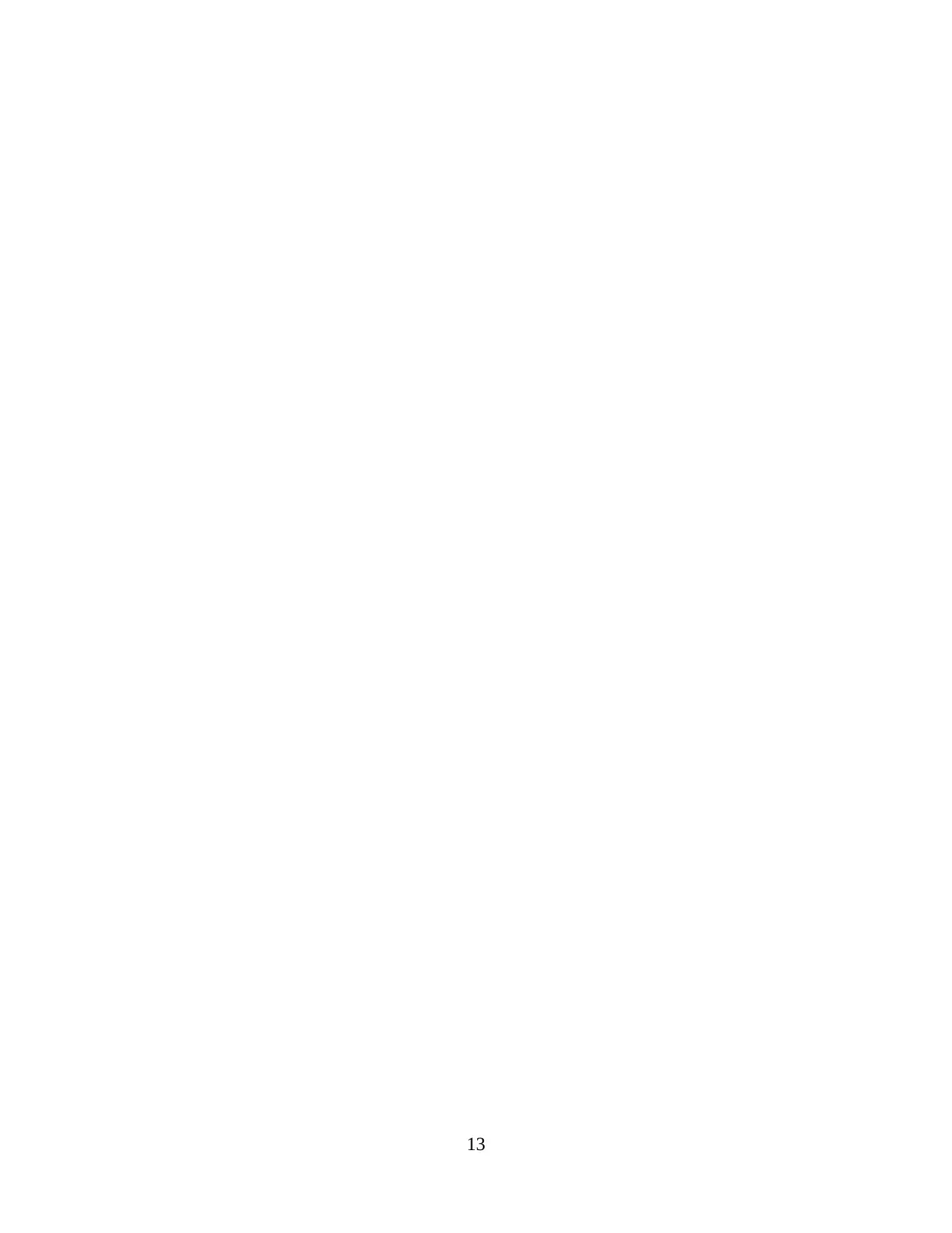
13
1 out of 13
Related Documents
Your All-in-One AI-Powered Toolkit for Academic Success.
+13062052269
info@desklib.com
Available 24*7 on WhatsApp / Email
![[object Object]](/_next/static/media/star-bottom.7253800d.svg)
Unlock your academic potential
© 2024 | Zucol Services PVT LTD | All rights reserved.





